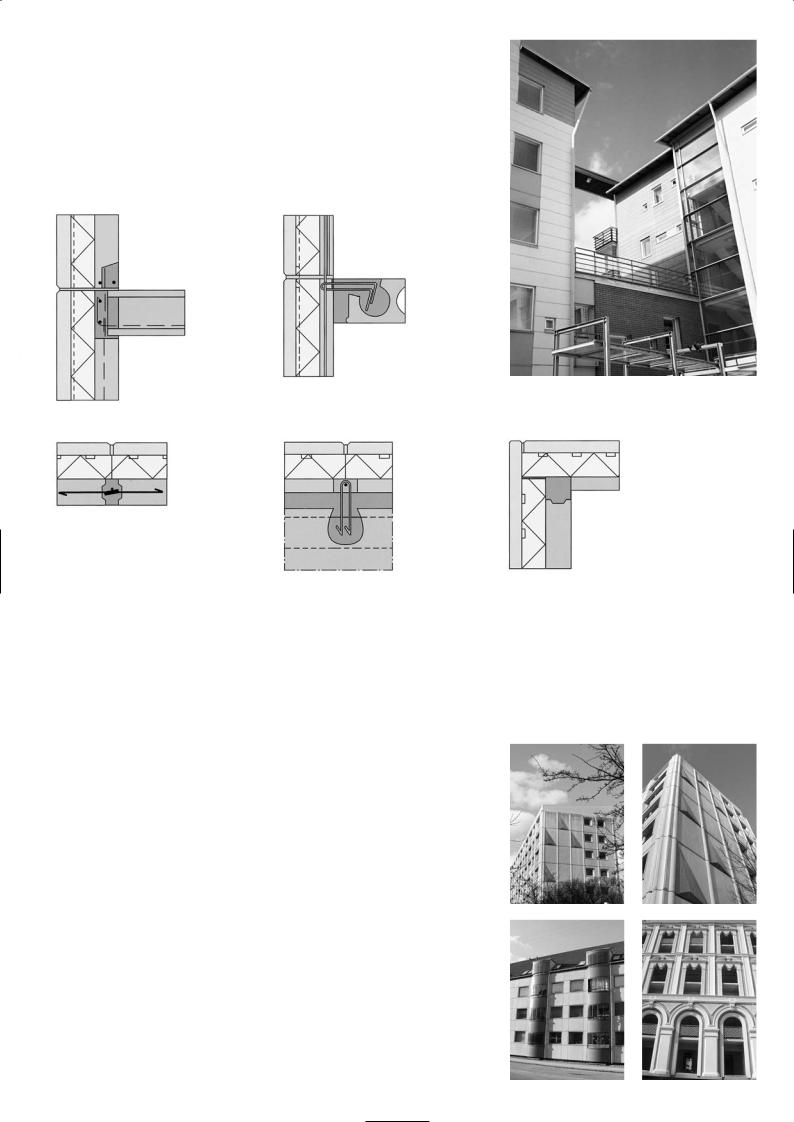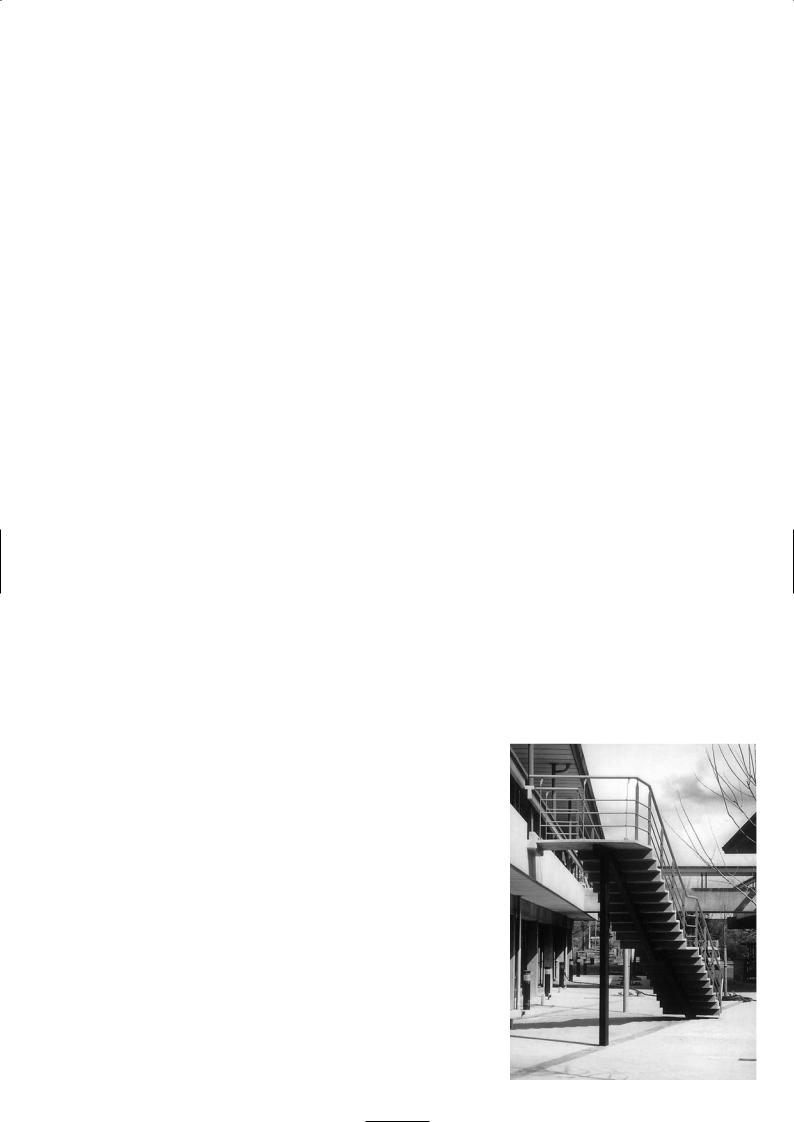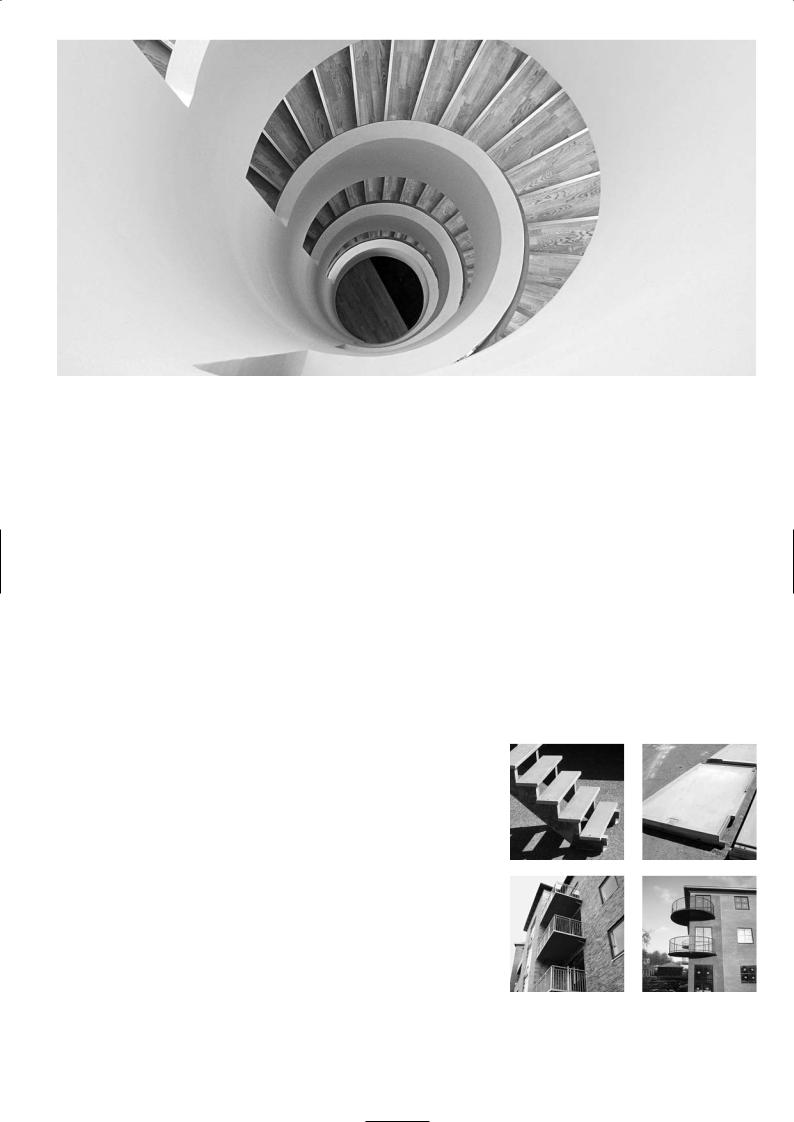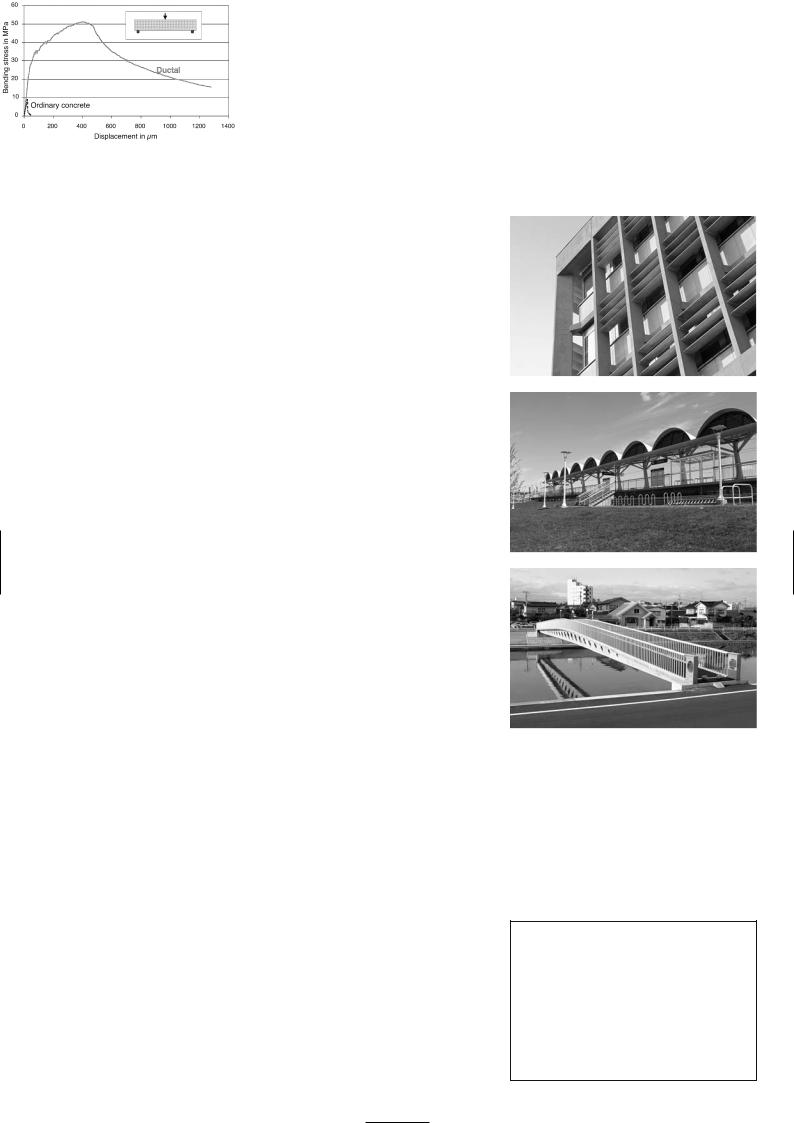
- •Dry Cast Concrete
- •Wet Cast Concrete
- •Self-Compacting Concrete (SCC)
- •Sandwich Panel Construction
- •Precast Light Concrete
- •Precast Ultra Concrete
- •Types of Surface Finishes
- •Support and Fixings
- •Cost and Construction Matters
- •Glass Fibre Reinforced Concrete
- •Compact Reinforced Composite
- •Useful Contacts
- •Illustration Credits

Typical sandwich panel design
Connection details, left to right:
Floor to façade
Side wall to façade
Corner solution
Precast Light Concrete
The trend in modern building construction towards more lightweight ‘high-tech’ |
Examples of GRC panel designs |
|
|
façades using glass curtain walling, resin coated aluminium and steel fascia, has |
|
disadvantaged the heavier precast and reconstructed stone cladding unit. In the |
|
1970s a lightweight precast cladding system developed by Pilkington and the |
|
BRE (Building Research Establishment) in the UK offered the same range of |
|
surface finishes as conventional reconstructed stone and precast but with a |
|
considerable reduction in panel thickness, from 150mm down to 20mm. Saving |
|
in panel weight was due to the strength and toughness of alkali resistant glass |
|
fibre strands that reinforced the cement mortar mix. Typically the skin thicknesses |
|
of the panels are between 15mm and 20mm, making its weight as much as 80% |
|
lighter than the corresponding precast concrete unit. Weight reduction of this |
|
magnitude offers substantial savings in transportation, handling and site erection |
|
cost. Glassfibre Reinforced Concrete or GRC is composed of a mortar mix of |
|
cement, selected crushed aggregates, sand, fillers, admixtures and water and |
|
alkali resistant glass fibre strands. The glass fibre is typically between 6-51mm |
|
long and 10 to 30 microns in diameter. It obtains its alkali resistance from a coating |
|
applied over the glass strands in the manufacturing process. For sprayed GRC it |
|
is recommended that 5% fibre by weight of total cement mortar should be |
|
contained in the mix, to achieve optimum tensile strength. Combinations of fibre |
|
lengths varying from 6-51mm and depending on the production process, will |
|
ensure that adequate bond strength develops between fibres and the cement |
|
matrix and encourage a quasi-ductile failure by fracture of the fibres. |
|
12

Hand sprayed GRC panels are usually produced with a water/cement ratio lower than 0.4 (low in comparison to most concrete) and a cement content of not less than 800kg/m3 (high for concrete). A typical hand sprayed GRC mix produced by Trent Concrete contains around 5% of glass fibre strands. A fully automated spray system for manufacturing GRC façade panels operated by Durapact in Germany uses fibre lengths of between 12-50mm at the dosage of 5% by volume of the concrete mix.
GRC is a very mouldable and adaptable material for forming architectural features such as cornices, parapets, quoins and other imitation stone features to dress building façades. As a lightweight cladding system for whole buildings it has gained a limited foothold in the façade market, due to some minor teething problems associated with brittleness, differential movement and crazing when it was first launched.
The development of more durable glass fibre strands, extensive testing of the product over many years and improvement to the mortar mix to reduce long-term brittleness, has given specifiers the assurances and compliance standards they require. The various techniques used to manufacture GRC products
– manual and mechanised spray methods and traditional wet casting – allows the material to be formed in a wide variety of shapes and profiles. It can be moulded easily to suit classical or modern architectural expression using complex profiles and curved or angular surfaces. Being cement based with no metal reinforcement, it has inherently good durability and chemical resistance. It is non-combustible and has high impact strength. It is not susceptible to rust staining or corrosion, and can be used in combination with insulating material and sound proofing. Constraining factors in performance are generally due to its relatively large thermal and moisture movement and low ductility.
In designing GRC two characteristics are important, the LOP value ‘The Limit of Proportionality’ and the MOR value ‘Modulus of Rupture’ which are derived from accelerated ageing and bending tests. Typical material properties for GRC panels can be determined from test data published by the GRCA in UK and similar organizations in Europe and shown in their guidance notes. This includes compressive strength, modulus, impact strength, poissons ratio, LOP and MOR values, ultimate tensile strength and shear strength. With such a high cement content and low water/cement ratios GRC panels are more resistant to surface weathering, moisture ingress and discoloration than reinforced concrete cladding panels.
The need for GRC cladding to be flexibly mounted on the supporting structure to accommodate thermal and moisture-induced movement is therefore important. Many of the problems associated with GRC have resulted from the rigidity of the fixing, from errors of installations or from introducing some other unintended restraint to panel movement. Wherever possible, design GRC panels as independent skins to allow maximum freedom to shape, curve and profile panels. Good detailing of panel size, reducing horizontal flat surface areas like window sills, which may collect surface water and create high moisture gradients in the panel, and avoiding panel shapes that wrap around a building corner causing large thermal movements, will ensure a longer service life.
A wide choice of mould material is available to achieve different surface textures, although timber and glass reinforced plastic are more commonly used. Colour and texture can be obtained by the use of fine aggregate facing material. Crushed rock, sands and gravels are usually employed in combination with white cement and pigments to produce reconstructed stone finishes. The finished face can have the aggregates exposed by acid washing, grit blasting or using retarding chemicals. Such finishes are generally similar to those obtainable with conventional precast concrete; however, with GRC, the maximum aggregate size is restricted to 10mm.
Top: Rolling and compacting GRC
Bottom: Spraying GRC
13

Precast Ultra Concrete
The growing emphasis on non-combustibility of raw materials, the rise in cost of hydrocarbons and high energy cost of production, led researchers back in the 1970s to look for the possibility of making a ‘defect free’ cement as a replacement material for organic plastics and aluminium. The major attraction of cement was simply the huge energy savings in manufacture. To produce 1m3 of cement, organic polymer or aluminium requires 10, 100 and 1000 GJoules respectively of energy. Clearly cement has a major advantage in energy saving because it hydrates with just the addition of water under normal air temperatures. There is no need to heat it. The big disadvantage is its low tensile and bending strength, and low fracture toughness due to the air-voids trapped inside. Removal of the internal voids, air pockets and capillary pores – the defects – from the ‘cement paste’ was made possible by introducing a small proportion of water soluble polymers which reduced inter-particle friction and surface tension and made the cement particles pack much closer. The increase in compressive strength of up to 300Mpa was phenomenal but its application was limited to injection moulding and extruding and not concrete structures.
Researchers in Denmark and France in the last ten years have developed ultra high performance concretes which can be precast in factories and poured in place just like conventional concrete. Ultra high strength from 100Mpa-350Mpa is achieved by controlling the particle-size distribution of the cement to minimise the void spaces between the cement grains. Some products use just neat cements, polymers and fine fillers with a combination or combinations of plasticisers and superplasticisers to make these earth dry mixes workable, as the water/cement ratio is extremely low at 0.2-0,3. Other ultra high performance products add very finely divided silica sand, filling the voids left by the cement particles. There is no coarse aggregate. The silica has the added advantage of reacting chemically with the cement paste to become an integral part of the matrix. A dispersion surfactant or superplasticiser is also necessary to achieve workability for placing as it is an earth dry mix with a low water/cement ratio.
Ultra high performance concretes are used increasingly for a range of structural applications, and standards in a number of countries are being revised to accommodate these improved materials. Often they are more brittle than conventional precast concretes, which can lead to problems in failure mode as well as under service conditions. One way of overcoming this problem is to provide ductility by incorporating steel fibres in the matrix.
The material properties are far superior to ordinary concrete in every respect. Apart from their high compressive strength, the bond and shear strength is far greater, Young’s Modulus is much improved, while the tensile strength and ductility are enhanced with the introduction of steel fibres. Precast ultra materials are structural grade material for precasting slim lightweight load-bearing façade elements, thin cantilever balcony slabs, elegant staircases and supporting columns
and remarkably slender bridge structures. CRC staircase The two products highlighted are CRC (Compact Reinforced Composite)
which is a fibre reinforced cement with strengths ranging from 150 to 300 Mpa, developed by Aalborg Portland and marketed by CRCTechnology in Denmark. The other is Ductal® developed by Lafarge and Bouygues in France. They both belong to a special group of ultra high performance fibre reinforced concretes.
What is CRC?
One formulation of CRC (Compact Reinforced Composite) produces very high bond strength just like superglue, due to the large content of micro silica and steel fibres that can be added to the concrete mortar mix. It can glue together joints between two reinforced concrete sections, in many ways similar to welding steel sections and has been called ‘weld cement’. When it is specifically required for jointing structure the formulation is called JointCast. Reinforcing bars need only have a bond length of eight times the bar diameter for a full tension lap as opposed to 30 or 40 diameters for a conventional concrete. For practical reasons the minimum gap between joints are usually 80mm or 100mm wide to be able to pour and compact the JointCast mortar.
In precast ultra applications, CRC is modified to produce strengths between 100-300Mpa according to project requirements. It is supplied to precast manufacturers as a dry powder with the special CRC binder. CRCTechnology will help the producer find a suitable local sand and to source steel fibre to add to the
14

binder. Water is added to the mix under controlled conditions. The high strength of CRC with its mortar-like consistency allows for very close rebar spacing, making it possible to precast thin, lightweight structural elements such as balcony slabs and staircases. The steel fibres are necessary to maintain the ductility of the material but are not sufficiently robust to support applied loads nor control deflection, therefore reinforcement is necessary. Typical proportions for making 1m3 of a 200Mpa mix run as follows:
—CRC binder 1,000kg
—sand 1,290kg
—steel fibre 180kg
—water 150kg
A conventional pan mixer can be used for mixing CRC. The mixing time is between 5 and 8 minutes after the water is added. The bundles of steel fibres are added part way through the mixing. The material is sensitive to temperature change as the high superplasticiser dosage tends to retard the hardening, and should not be used below 5° C. At 20° C the initial set will start after 7-8 hours, with the compressive strength of 60Mpa achieved after 16 hours. Because of its very low water content, in hot weather and drying winds the surface should be covered as quickly as possible to prevent evaporation, and the structure enclosed by tenting with tarpaulins. Surface finishing is a problem as the mix is very sticky. A spike roller used for screeding is quite effective for levelling the surface.
Where CRC has been engineered to its full potential and a balcony slab made to cantilever the span without need of a supporting column, contractors have found it to be the cheapest option. In Denmark there are now three precast companies all doing quite well offering CRC precast slabs, staircases, manhole covers, slender beams, load-bearing columns and façade panels. While compressive strength and ductility is greatly enhanced, stiffness is only slightly higher than for normal concrete, which means that deflection has to be carefully considered and controlled by reinforcement. Allowances have also to be made for drying shrinkage due the high cement content and that is catered for by detailing additional reinforcement.
The CRC binder is more expensive than cement and the steel fibre content also leads to a higher price for CRC. On the other hand, elements are typically one third the volume of conventional concrete. This means that for the applications used in Denmark – typically balcony slabs and staircases – the price for CRC is equivalent to alternatives in steel or concrete. The price of CRC elements can even be lower than alternatives in steel or concrete, when a cantilevered CRC slab replaces a conventional concrete or steel balcony slab supported on columns.
Several Danish architects have produced spectacular design such as the Spiral Staircase in Copenhagen documented as a case study of CRC applications.
CRC circular balustrade
CRC staircase flight
CRC balconies
Balcony panels
CRC balconies
15

What is Ductal®?
Ductal® is a concrete composed of cement particles, fibres, special fillers and plasticisers that is able to fully hydrate with the minimum of added water. It has a water/cement ratio of just 0.2. It is the outcome of over ten years of collaborative research between Lafarge the material manufacturer, Bouygues the contractor and Rhodia, a chemical manufacturer. Through intensive research and development work, the material has been patented, refined and commercialised. Fifteen universities and six testing laboratories in different countries have also contributed to the research effort.
In May 2002 design guidance rules and material recommendations were formulated in France for the use of Ductal® in structural applications. These recommendations were established by a working group comprising representatives from leading construction companies, building control agencies, suppliers, certification authorities and coordinated by SETRA (Road and Traffic Government Agency). The material consists of cement and cementitious fillers carefully blended and graded, with a particle size distribution ranging from a maximum of 600μm (0.6mm), down to less than 0.1μm to obtain the densest packing with the minimum of void spaces. It has sand fines but no coarse aggregates. It is a super high strength concrete mortar with the minimum of internal and external imperfections such as micro-cracks, air voids and pore spaces. This enables the material to achieve a greater percentage of its ultimate load-carrying capacity and enhances its durability properties.
The material has a compressive strength ranging from 200Mpa-350Mpa, but lacks sufficient ductility. The inclusion of steel fibres drastically improves the tensile strength and provides a substantial level of ductility. The various formulations and applications of Ductal® are based on an optimisation of the material composition with steel and polypropylene fibres. For example, to enhance its structural performance steel fibres are included and the material is also heat treated to reduce creep and shrinkage strain. For every application the technology can be adjusted to achieve the optimum performance required.
For structural grades, Ductal®-FM is prescribed with steel fibres, for a smooth decorative material that can be handled Ductal®-FO is recommended which has polypropylene fibres, while for enhanced fire resistance Ductal®-AF is prescribed which has a combination of steel and polypropylene fibres.
The fresh mixing of these materials as well as the controls that have been developed, makes it relatively easy to handle in terms of flow and self-compaction. With minor adjustments, most conventional concrete batching equipment is suitable for mixing it. The matrix gives a very fine ‘bone china’ surface finish that can be moulded to replicate any kind of profile or intricate pattern. By using adequate pigments a range of coloured concretes can be achieved for architectural and decorative applications.
A typical load-deflection curve for Ductal® under a three point loading test is shown in the drawing. The material exhibits linear elastic behaviour up to first crack and has considerable ductility thereafter until the ultimate flexure load is reached, where upon it begins to yield with plastic failure until rupture. It has an ultimate bending strength which is over twice its first crack stress and more than ten times the ultimate stress of conventional mortars. With such high strength and ductility structures can be designed without any secondary passive reinforcement and no shear reinforcement.
The use of this concrete-like material has almost unlimited possibilities of appearance, texture and colour. It has excited architects by giving them access to an unexpected new world of shapes and forms. Ductal® has been used in architectural applications like the bus shelters in Tucson (USA), façade panels in Monaco and the Kyoto clock tower in Japan. A number of footbridges have been constructed using Ductal®, they are the Sakata Mirai in Japan, the bridge in Sermaises in France, the one in Sherbrooke in Canada and the Seonyu Footbridge in Seoul, highlighted as a case study.
Examples of Ductal® applications: Brise soleils on apartment building Curved roof for train station in Calgary Sakata Mirai footbridge, Japan
Ductal® load-deflection curve
16
